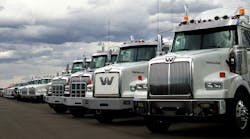A lot of people in the trucking industry have issues with symmetry when it comes to tires. They believe that all of the tires on the vehicle must be identically matched. The steer tires must have the same tread design as the tires on the drive and trailer axles. With the appearance of perfect uniformity, this policy of matched tires is considered by many to be the best approach, which potentially yields the best results.
But the more important definition of “matched” refers to the diameter of tires in a dual assembly. If they are the same size and tread design with the same amount of tread depth, then they will definitely be matched as far as diameter is concerned. However, if one of the dual tires needs to be replaced down the road, the difference in tread depth becomes a critical factor in the lives of both tires.
When the difference in diameter between dual tires is as small as 5/16 of an inch, the larger tire will drag the smaller tire about 13 ft. every mile. The larger tire will also experience accelerated center tread wear and will be supporting more of the load so it is more likely to develop heat-related damage, while the smaller tire will probably develop a series of flat spots around the tread as it scuffs the pavement trying to catch up.
According to industry standards, the maximum difference in diameter for standard truck tires in a dual application is 1/4 of an inch. When this is converted to tread depth, the result is the difference between identical dual tires should not be more than 4/32 of an inch. For the uniformity-obsessed fleets, replacing one dual tire that is half worn with a brand new one preserves the appearance of being perfectly matched, but diameter is still diameter. Every 32nd of an inch over a 4-in. tread depth difference is going to reduce the tread life of both tires.
There are also a lot of tractors and trailers with different tread designs on the drive and trailer positions. While one might think that the 4/32 rule still applies because they have the same size molded on the sidewall, it’s important to remember that tire sizes are nominal when it comes to the actual dimensions. The word “nominal” makes matching dual tires from different manufacturers even more complicated because it means that the size is a “designated or theoretical size that may vary from the actual,” according to Merriam-Webster.
Need proof? Consider this: Five popular 295/75R22.5 and 275/80R22.5 drive tires with similar tread designs from different manufacturers have diameters that range from 40.5 to 41.1 in. and original tread depths that range from 26 to 32 when they are new. In one combination, the diameter and tread depth are identical; yet in another, the diameter is only off by 2/10 of an inch, but the tread depth differs by 5/32 so the tires are matched and the rule is wrong. In yet another combination, the starting diameter is off by over half an inch and the difference in tread depth is only 4/32, which means the rule is wrong again—this time for a different reason.
When dual tires are not from the same manufacturer and the tread design is different, then mismatches are inevitable. In most cases, they will be minor and simply lower the miles per 32nd. And while the 4/32 rule does not always result in tire diameters that are within the 1/4-in. limit, it should prevent the most severe cases when the larger tire is overloaded to the point that it overheats and fails.
Kevin Rohlwing can be reached at [email protected]


